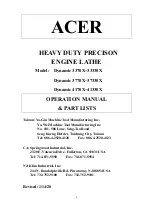
19
Copyright © 2020 Quality Machine Tools, LLC
PM-1440GS v3 2020-10
GAP BED
A 7-1/2 inch long section of the bed at the headstock end can
be removed to allow turning of diameters up to 19-3/4 in., Fig-
ure 3-21.
To remove the gap insert back in the pusher screw one or two
turns, then remove the four large socket head screws secur-
ing the insert to the bed. To minimize cosmetic damage, cut
through the paint and filler along the joint between insert and
bed using a sharp knife or pointed scraper.
Jack out the two locating pins arrowed (exposed threads and
hex nuts), then tap the insert free with a soft-face mallet.
Before re-installing the insert, be certain that all mating surfac-
es are scrupulously clean. Set the insert in place, lightly tap in
the two locating pins, then install the four large bolts (snug, but
not fully tightened). Jack the insert to the right with the pusher
screw to close the gap, if any, between the ground surfaces of
the bed ways at the join (a visible parting line is acceptable, but
a discontinuity that snags the saddle is not). If a satisfactory
join cannot be achieved, it may be necessary to remove and
reinstall the insert from scratch.
Figure 3-21
Gap insert
Pusher
screw
STEADY & FOLLOWER R
ESTS
The hinge-type steady rest, Figure 3-23, can be mounted any-
where along the lathe bed. It makes possible cutting opera-
tions on long, slender workpieces between centers, or held at
one end by chuck. The steady rest is often used in combina-
tion with the saddle-mounted follower rest, Figure 3-24.
Figure 3-23
Steady rest
(representative)
LOCKING THE SLIDES
Figure 3-22
Compound & saddle locks
When face-cutting large diameter surfaces, for instance, it is
often desirable to lock the saddle. Less frequently it can be
helpful to lock, or at least stiffen, sliding motion of the com
-
pound, Figure 3-22.
Access to the saddle lock screw may be limited by the DRO
scale cover. If so, it may be desirable to replace the installed
screw (socket head) with a conventional hex head, or a ratch
-
eting lever screw.
To set the fingers on the workpiece, first swing open the upper
casting. Make certain that all three fingers are freely adjustable
by thumbwheel. If not, loosen and re-lock the set screws (ar
-
rowed). Raise the two lower fingers to just touch the workpiece
— not deflecting it — then close and secure the upper casting.
Lower the top finger to just touch the workpiece, clamp the
frame, then apply oil at the point of contact.
The follower rest, Figure 3-24, is secured to the saddle with
two 8 mm socket head screws. Adjust the follower fingers as
described for the steady rest.










































